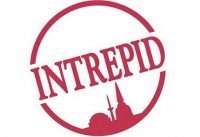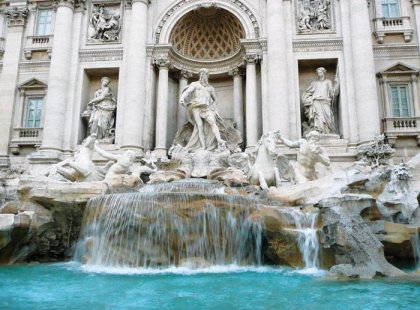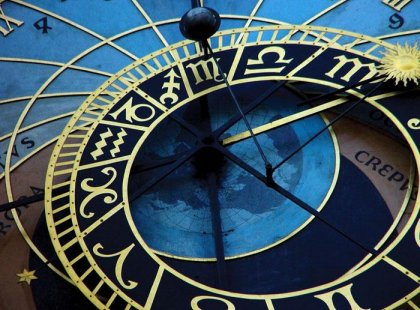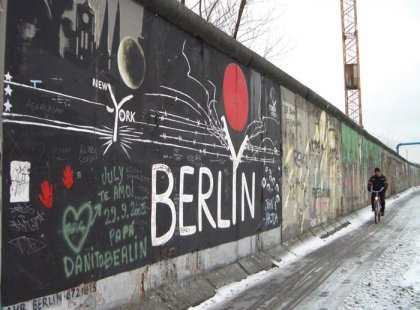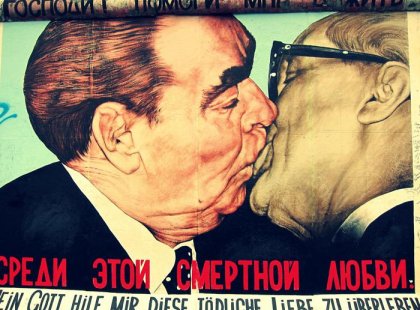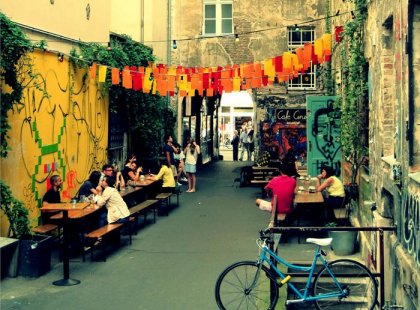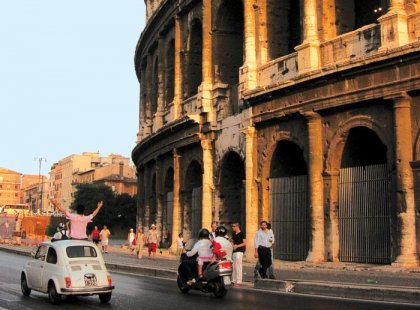Berlin to Rome
22 days
From
$ 3065
Duration22 days
Visit Germany, Poland, Czech Republic, Austria, Hungary, Slovenia and Italy. Embark on a tour of Europe as you travel from Berlin to Rome visiting Germany, Poland, the Czech Republic, Austria, Hungary, Slovenia and Italy. Discover some of the highlights of Europe from the remains of the Berlin Wall to the Trevi Fountain in Rome. Unearth the secrets of Germany and Poland, live it up in the Czech Republic, eat cake in Austria, head outdoors in Hungary, see dramatic scenery in Slovenia and discover a wealth of antiquities in Italy. From the backstreets of Prague to the canals of Venice and beyond, this journey will be one to remember.
-
Duration: 22 daysService level: Basic
-
Starts in: BerlinPhysical Grading: Light
-
Ages: 15+

Itinerary
Day 1: Berlin
Start place: Berlin
Guten Tag! Welcome to Germany. Your adventure begins with a welcome meeting at 6 pm on the first day of the trip. There are no activities planned until this important meeting so feel free to arrive at any time during the day. Please check the hotel notice boards or with reception about where and when it will take place. If you can't arrange a flight that will have you arriving at the hotel by early evening, you may wish to arrive a day early so you're able to attend the meeting. We'll be happy to book additional accommodation for you (subject to availability). If you're going to be late, please inform the hotel reception. We'll be collecting your insurance details and next of kin information at this meeting, so ensure you have all these details to provide to your leader. In the evening, you might like to get out and mix with the local hip young things in one of the city's many bars.
Day 2: Berlin
Morning and part of the afternoon are free, so perhaps check out the remaining fragments of the Wall scattered around the city, dropping by Checkpoint Charlie to see where the main gate between East and West Berlin used to stand. Or visit the Brandenburg Gate, the iconic Reichstag building or the powerful Holocaust Memorial. There also is some great street art in Berlin, especially around the neighbourhoods of Mitte, where our hotel is, Kreuzberg and Friedrichshain (where our hotel is). In late afternoon, you'll board an overnight train for Krakow in Poland. Don’t be late!
Meals: B
Day 3: Krakow
Arrive into Krakow, your base for the next two nights. After arrival, follow your leader on a city orientation walk and step back in time as your wander the World Heritage-listed old town, shopping for amber jewellery or local crafts. Discover Wawel Royal Castle which sits atop a hill next to the Vistula River. Check out the 13th-century town square of Rynek Glowny and get a glimpse of the impressive St Mary's Basilica (which features an extraordinary wood-carved Gothic altarpiece). Another beautiful church is the neo-Gothic St Francis' Basilica, which boasts some of Poland's best Art Nouveau. This city is also home to the second oldest university in Central Europe, Jagiellonian Univeristy (the oldest is in Prague). It counts Copernicus and Pope John Paul II among its alumni.
Day 4: Krakow
If you can tear yourself away from Krakow on your free day, head out to the Wieliczka Salt Mines, a network of tunnels and chambers some 135 metres below the ground. This is a salt mine that has been in operation for over 700 years. The mine has a labyrinth of tunnels, pits and chambers, all hewn by hand from solid salt, with beautifully adorned chapels and underground lakes. Don't miss a look at the elaborate salt chandeliers and carvings in the Blessed Kinga Chapel. Alternatively, you might like to take a sobering day trip out to Auschwitz and Birkenau, the sites of some of the Holocaust's worst atrocities. Perhaps end the day in one of Krakow's many cellar restaurants for a plate of pierogi and a drink.
Day 5: Prague
Take a minivan trip to the town of Ostrava (approximately 2.5 hours), then board the train to Prague (approximately 3 hours). After arrival and check in to our hotel, the leader will show you the highlights of this beautiful city on an orientation walk. Prague's architecture can be traced from the Middle Ages through to the avant-garde of the Gehry-designed Dancing Building (also called the Fred and Ginger Building). Spend your free afternoon at Prague Castle, the biggest in the Czech Republic, where you'll find the famous St Vitus Cathedral and Golden Lane. Wander through the old Jewish Quarter to see what remains of the city's formerly large Jewish community.
Day 6: Prague
Another day in Prague and so many possibilities. You have a free day to discover the Bohemian Prague; extravagant, political, passionate, and fueled with Czech Water. Learn how the Bohemian artists, writers, dissidents, and the Bohemian mentality shaped the nation. Don’t forget to sample some of the best Czech beers and traditional and modern Czech snacks along the way. If you feel like going for a day trip out of the city, ask your leader to help you organise a trip to Kutna Hora. See Church of Santa Barbara and Sedlec ossuary or The Church of Bones if you like, a small Roman Catholic chapel that contain the skeletons of between 40.000 and 70.000 people. Back in Prague remember that the Old Town at night is truly special. There are many great restaurants and pubs, some in old vaulted cellars. The nightlife in Prague is some of the best in Central Europe. Whether dance clubs, beer-halls or underground absinthe bars are your thing, there's something for everyone. The city also boasts one of Europe's most respected jazz scenes. If you find yourself out until the early hours in a jazz club, have a wander along Charles Bridge or the Old Town Square as the sun rises for magical photo opportunities.
Day 7: Cesky Krumlov
Depart Prague and travel by bus to Cesky Krumlov (approximately 4 hours). This picturesque medieval town dates back to the 13th century and appears to be plucked straight out of a fairytale. Wander the cobbled alleyways of the old town and admire the buildings. Great way to discover the town is with to join a tour guided by a local. You will learn about the architectural symbolism and old town mysteries from an expert. Climb up to the castle perched on a hill and check out its fabulous Masquerade Hall. Sensational views can be seen from the tower. Weather and time permitting, take a relaxing 2–3 hour rafting or canoeing trip along the river that runs right through town.
Day 8: Vienna
Take a minivan to the cosmopolitan city of Vienna. There is so much to explore here! After arrival, your leader will help you take your picks by showing you the city centre on foot. Afternoon will be free to explore the city. Art lovers will be delighted by the vast array of museums on offer, including the Albertina, the Leopold, Kunsthalle Wien and the Museum of Modern Art. Those with an interest in 19th and 20th century Austrian art should visit the Belvedere Palace, home to Gustav Klimt's painting 'The Kiss'. Check out the colourful Hundertwasserhaus or admire the dome of the Secession building. Perhaps visit Hofburg Palace, once the imposing winter retreat of Habsburg royals and now the official residence of the Austrian president. Apparently no visit to Vienna is complete without attending an opera or concert. Check what Vienna State Opera House has on offer (worth doing that in advance) and immerse yourself in the city’s immense musical pedigree.
Day 9: Vienna
Free day in Vienna will give you more time to visit places you didn’t manage to get to yesterday. Climb the tower of St Stephen's Cathedral, take a spin on the Prater Ferris Wheel or catch a dressage show at the Spanish Riding School. Head to Schoenbrunn Palace, which was designed by Empress Maria Theresa herself. The gardens are free to all visitors but there is a charge for entrance and tours of the palace. Avoid long queues by pre-booking your tickets at schoenbrunn.at. After all this sightseeing, you might like to indulge in a traditional Viennese coffee and Sacher torte, before capping off the evening with a spot of Mozart, Bach or Schubert at the opera house.
Note: The Spanish Riding School doesn't operate throughout the summer months. You will need to book tickets in advance to see the performance of the Lipizzaners. Phone +43 (0)1 505 77 66 55 or e-mail info@viennaticketoffice.com to arrange tickets.
Note: The Spanish Riding School doesn't operate throughout the summer months. You will need to book tickets in advance to see the performance of the Lipizzaners. Phone +43 (0)1 505 77 66 55 or e-mail info@viennaticketoffice.com to arrange tickets.
Day 10: Budapest
Travel from Vienna to Budapest by train (approximately 3 hours). Known as the 'Pearl of the Danube', Budapest's grand architecture and boulevards evoke a bygone era. Your leader will introduce you to the city by taking you for an orientation walk. With so much to see and do, in your free time head out to Statue Park to see the communist monuments that were removed from the city after the fall of the Iron Curtain. One unmissable activity is a soak in one of the city's many hot thermal baths. The baths feature pools of varying degrees; some even have whirlpools or built-in seats where you can relax or play a game of chess. Dinner comes, best way to feats in Budapest is to grab a bowl of hearty Hungarian goulash.
Day 11: Budapest
Enjoy a free day in the Pearl of the Danube. Perhaps explore the historical Buda castle and palace complex of the Hungarian kings. Forget about the bustling city and lose yourself in the history of the winding streets of Castle District, which dates back to the 13th century and soak up the atmosphere of a beloved mid-19th century local pastry shop. In the afternoon perhaps take one of the tourist boat trips along the Danube River for spectacular views of the Parliament Building, the Castle District and the bridges linking Buda to Pest. The spectacle is particularly beautiful at night.
Meals: B
Day 12: Bled
Take a train (approximately 8 hours) to Ljubljana, followed by a connecting bus to the town of Bled , situated at the edge of the Julian Alps. Arrive in late afternoon and follow your leader to the shore of beautiful Lake Bled, from where all of the town’s attractions can be seen and explained. For a taste of the local cuisine, some Bled cake is a must, made of vanilla, custard, cream and pastry. Alternatively, join the group for dinner (optional) to taste some Slovenian specialties.
Meals: B
Day 13: Bled
No better place to get active than in Bled. You have a free day to go for a lake walk (or run if you feel like!) in the morning, and perhaps enjoy a full day adventure around Triglav Massive. There are many outdoor activities available here to get the blood pumping, such as rafting, caving, canoeing and swimming. Why not hire a bike and head four kilometres out of town to Vintgar Gorge, where you can take a walk through a beautiful natural canyon. Perhaps explore Bled Castle, perched atop the cliff overlooking the lake, or catch a pletna (small wooden boat) over to the island in the middle of the lake to ring the wishing bell. Another option is to take a day trip to Lake Bohinj, situated in a glaciated valley. There, you can ascend Mt Vogel by cable car for awesome views of the ranges. If the weather is clear, you may even see out to Triglav, the highest peak in Slovenia (note that the weather on top of Mt Vogel varies greatly; it's a ski resort in the winter).
Check with your leader for all the options and book in advance not to miss out. If you don’t feel like going crazy, just enjoy the beauty of the place; perhaps find a quite spot near the lake and spend a day reading your book.
Check with your leader for all the options and book in advance not to miss out. If you don’t feel like going crazy, just enjoy the beauty of the place; perhaps find a quite spot near the lake and spend a day reading your book.
Day 14: Venice
Travel by train through stunning scenery to one of the world's most unique cities, Venice (approximately 5.5 hours). A city of canals, Venice is built over a hundred small islands connected by 400 bridges. Head out for an orientation walk with your tour leader. The best way to do this is by foot, taking in all the famous sights – the Grand Canal, the Rialto Bridge, the Palace of the Doge (the ruler of Venice), the Piazza San Marco with its golden Basilica, and of course the evocative Bridge of Sighs. Wander the cobblestone streets and spacious piazzas, crossing hundreds of tiny bridges. There are shops, markets, galleries and churches around every corner. Don't miss taking a gondola trip through the romantic canals or sampling a slice of region's desert speciality, tiramisu (coffee-soaked sponge cake). Conclude the day by tasting delicious Italian food during the farewell dinner with your group, toasting to all the adventures and great memories made.
Day 15: Venice
Today is free for you to enjoy as you please. Set out to discover more of Venice in detail. Venice being described as the most beautiful city built by man and one of Europe’s most romantic cities is never short of things to discover.
Day 16: Venice
Today venture out and explore Venice. There are only two ways to get around this city – on foot or by boat. Some of the more popular sights include Doge's Palace, the Piazza and Basilica di San Marco and the Bridge of Sighs. Take the vaporetto (water bus) over to the island of San Giorgio to climb the bell tower for the best view of Venice. No trip here would be complete without a journey down the Grand Canal in a Venetian gondola. It's a common way for visitors to see the major canal routes from an immersive perspective. While away your day in the busy San Marco square and be sure to try the local tiramisu and Italian coffee that's on offer. There’s creativity everywhere, overflowing into the canals; see it in the venetian glass in Dorsoduro or down the streets spreading out from Campo Santo Stefano, lined with unique galleries and small boutiques. Visit the Palazzo Ducale, overflowing with paintings by Italian masters, and contrast it with the modern Guggenheim. Simply enjoy getting lost crossing the hundreds of bridges and uncovering your own slice of Venice. In the evening, perhaps join your fellow travellers for a group dinner at a local restaurant. Venice is famous for its specialities of fresh lobster and squid ink spaghetti dishes, so make sure you give one a try.
Day 17: La Spezia
This morning spend the day travelling by train to the once important naval base of La Spezia, now the gateway to the gorgeous Cinque Terre, or ‘Five lands’ in English. The name comes from the five tiny villages – Monterosso, Vernazza, Corniglia, Manarola and Riomaggiore – whose position, wedged into a series of coves between sheer cliffs, makes it one of the highlights of the whole of Italy. The journey usually takes between five and seven hours either via Milan or via Florence (depending on the best available connection), and is a very scenic trip through the north of Italy. On arrival in La Spezia there won't be too much time to explore yet, but after checking into your hotel perhaps get your bearings of the area with a short walk around the pedestrian zone on Via del Prione to the gardens along the harbour, or head out for dinner with the group.
Day 18: La Spezia / Cinque Terre
Today it is highly recommended to venture out on the footpaths of Cinque Terre (Five Lands), a region of Italy famed for its coastline and pastel villages. The footpaths that run between the villages were once the only way to travel in the region, and take you through olive groves, vineyards and on to idyllic vistas. You can choose to walk just a few sections, which will still unveil a great amount of majestic scenery. Some sections of path can be difficult, as there are challenging uphill stretches, narrow paths, steep cliffs and foot bridges. Please remember to bring comfortable footwear such as trainers or light hiking shoes. It's also possible to take the train between any of the villages or back to the group's base in La Spezia whenever you want. After working up an appetite, take advantage of the foods of the Liguria region with a pesto class. Focaccia is also a speciality in this area and makes a great start to lunch. Upon return to La Spezia in the evening, there's no better way to recover from your day of walking with more indulgence in delicious Mediterranean food.
Meals: B
Day 19: Florence
Depart Cinque Terre today and catch a train to Florence (approximately 3.5 hours). On arrival, check into the hotel and go for a brief walk around the immediate area to get your bearings. Florence is one of the most culturally rich and beautiful cities in Italy, known to many as the beating heart of Tuscany. The Medicis, Leonardo da Vinci, Raphael, Brunelleschi, Machiavelli, Donatello and Michelangelo all lived in Florence at the height of their creative reign. Food is a major part of the city's identity, so perhaps explore some of the culinary delicacies on offer from across Tuscany. Regional specialities are noted for their simplicity and fine flavour, and the use of high-quality olive oil, cannellini beans and fresh herbs. Meat lovers should try the bistecca alla fiorentina, a huge T-bone steak that's usually shared between two people, or ribollita, a thick delicious vegetable soup with bread, beans and greens. Panforte is the signature sweet treat.
Meals: B
Day 20: Florence
Head out into the centre of Florence. It's impossible to see everything in this Renaissance wonderland, however, so take your time and enjoy it. Be captivated by the culture-rich atmosphere of Florence, from family-run vineyards on the outskirts of the city to the Duomo’s magnificent marble facade. Maybe start with a visit the Galleria dell'Accademia where you can see Michelangelo's famous statue of David. Stop by the Uffizi, one of the world's oldest art galleries, or walk up to Piazzale Michelangelo, which is set on a hill on the south bank of the Arno River, to take in beautiful views of the city – a lovely way to while away the day. There are plenty of sights to see during your time in Florence.
Meals: B
Day 21: Rome
In the morning, take the train to Rome (approximately 2 hours), and remember that while here, the best attitude is ‘when in Rome’! Join your leader on an orientation walk around the city, where you see some of the iconic sights such as the Colosseum and Arch of Constantine, the Forum (centre of ancient Rome), the Victor Emmanuel Monument, the Pantheon, Spanish Steps, Via Dei Condotti and Piazza Venezia. Recharge with a slice of pizza and a strong espresso at the Piazza Navona or throw a coin into the Trevi Fountain and make a wish to return to the 'Eternal City'. No visit would be complete without a trip to Vatican City and St Peter's Basilica. Entry to the Basilica is free and there's a small charge to climb the dome for a panorama over the city. Art-lovers should visit the Sistine Chapel to admire the timeless work of Michelangelo, while history buffs will enjoy a jaunt through the ancient halls of the Pantheon. Rome is packed full of restaurants and trattorias that cater to every taste and budget. Local specialities tend to be quite heavy, and include pastas such as carbonara (egg, cheese and bacon) and amatriciana (tomato, bacon and chilli). Eating in trattorias will give you a chance to sample some Italian wines, with house choices usually very good and affordable. Head out in the evening with the group for a final farewell gastronomic fling.
Meals: B
Day 22: Rome
Your 'Berlin to Rome' trip comes to an end on the final morning. There are no activities planned for today and you're free to depart the accommodation at any time. As there is so much to see in Rome we recommend you to stay a little longer. We are happy to book additional accommodation for you (subject to availability). Please speak to your agent at the time of booking.
Inclusions
Included
- Budapest market visit and picnic
-
Transport
Metro, Overnight sleeper train, Private vehicle, Public bus, Taxi, Train -
Accommodation
Guesthouse (2 nights), Hostel (7 nights), Hotel (11 nights), Overnight sleeper train (1 night)
